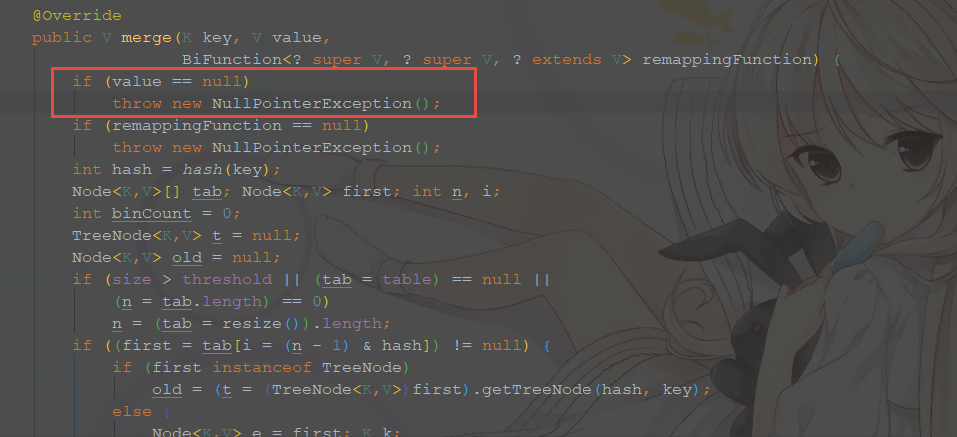
List<User> list = Lists.newArrayList();User a = new User("a", "12", null, "121", LocalDateTime.now(), new Date());User b = new User("b", "12", "1223", "121", LocalDateTime.now(), new Date());User c = new User("c", "12", "1223", "121", LocalDateTime.now(), new Date());User d = new User("d", "12", "1223", "121", LocalDateTime.now(), new Date());User f = new User("a", "12", null, "121", LocalDateTime.now(), new Date());list.add(a);list.add(b);list.add(c);list.add(d);list.add(f);Map<String, String> collect = list.stream().collect(Collectors.toMap(User::getName, User::getPassword, (key1, key2) -> key2));
问题
如果是 继承 toMap的 话 value的值 不能说 null 不然会报错 
正常的map 是可以的
需要对一个List中的对象进行唯一值属性去重,属性求和,对象假设为BillsNums,有id、nums、sums三个属性,其中id表示唯一值,需要nums与sums进行求和,并最后保持一份。
例如说:(“s1”, 1, 1),(“s1”,2,3),(“s2”,4,4), 求和并去重的话,就是(“s1”, 3, 4),(“s2”,4,4)
ArrayList<OrgExMngYlwlCollectDay> arrayList = Lists.newArrayList();OrgExMngYlwlCollectDay orgExMngYlwlCollectDay = new OrgExMngYlwlCollectDay().setInterceptOrgCode("1111").setInterceptOrgName("测试").setInterceptFailedSum(12).setInterceptShouldSum(122);OrgExMngYlwlCollectDay orgExMngYlwlCollectDay1 = new OrgExMngYlwlCollectDay().setInterceptOrgCode("1111").setInterceptOrgName("测试").setInterceptFailedSum(11).setInterceptShouldSum(10);OrgExMngYlwlCollectDay orgExMngYlwlCollectDay2 = new OrgExMngYlwlCollectDay().setInterceptOrgCode("111111").setInterceptOrgName("测试").setInterceptFailedSum(11).setInterceptShouldSum(10);arrayList.add(orgExMngYlwlCollectDay1);arrayList.add(orgExMngYlwlCollectDay);arrayList.add(orgExMngYlwlCollectDay2);//核心代码 toMap KEY 为 code value 不变 如果两个重复 则 合并两个的 sum值List<OrgExMngYlwlCollectDay> collect = new ArrayList<>(arrayList.stream().collect(Collectors.toMap(OrgExMngYlwlCollectDay::getInterceptOrgCode, a -> a, (a1, a2) -> {if (a1.getInterceptOrgCode().equals(a2.getInterceptOrgCode())) {a1.setInterceptFailedSum(a1.getInterceptFailedSum() + a2.getInterceptFailedSum());a1.setInterceptShouldSum(a1.getInterceptShouldSum() + a2.getInterceptShouldSum());}return a1;})).values());
源码如下
/*** Returns a {@code Collector} that accumulates elements into a* {@code Map} whose keys and values are the result of applying the provided* mapping functions to the input elements.** <p>If the mapped* keys contains duplicates (according to {@link Object#equals(Object)}),* the value mapping function is applied to each equal element, and the* results are merged using the provided merging function.** @apiNote* There are multiple ways to deal with collisions between multiple elements* mapping to the same key. The other forms of {@code toMap} simply use* a merge function that throws unconditionally, but you can easily write* more flexible merge policies. For example, if you have a stream* of {@code Person}, and you want to produce a "phone book" mapping name to* address, but it is possible that two persons have the same name, you can* do as follows to gracefully deals with these collisions, and produce a* {@code Map} mapping names to a concatenated list of addresses:* <pre>{@code* Map<String, String> phoneBook* people.stream().collect(toMap(Person::getName,* Person::getAddress,* (s, a) -> s + ", " + a));* }</pre>** @implNote* The returned {@code Collector} is not concurrent. For parallel stream* pipelines, the {@code combiner} function operates by merging the keys* from one map into another, which can be an expensive operation. If it is* not required that results are merged into the {@code Map} in encounter* order, using {@link #toConcurrentMap(Function, Function, BinaryOperator)}* may offer better parallel performance.** @param <T> the type of the input elements* @param <K> the output type of the key mapping function* @param <U> the output type of the value mapping function* @param keyMapper a mapping function to produce keys* @param valueMapper a mapping function to produce values* @param mergeFunction a merge function, used to resolve collisions between* values associated with the same key, as supplied* to {@link Map#merge(Object, Object, BiFunction)}* @return a {@code Collector} which collects elements into a {@code Map}* whose keys are the result of applying a key mapping function to the input* elements, and whose values are the result of applying a value mapping* function to all input elements equal to the key and combining them* using the merge function** @see #toMap(Function, Function)* @see #toMap(Function, Function, BinaryOperator, Supplier)* @see #toConcurrentMap(Function, Function, BinaryOperator)*/public static <T, K, U>Collector<T, ?, Map<K,U>> toMap(Function<? super T, ? extends K> keyMapper,Function<? super T, ? extends U> valueMapper,BinaryOperator<U> mergeFunction) {return toMap(keyMapper, valueMapper, mergeFunction, HashMap::new);}
groupingBy
//以userID分组Map<String, List<WorkScheduleExcel>> importWorkScheduleList = workExcelList.stream().collect(Collectors.groupingBy(WorkScheduleExcel::getUserId));

